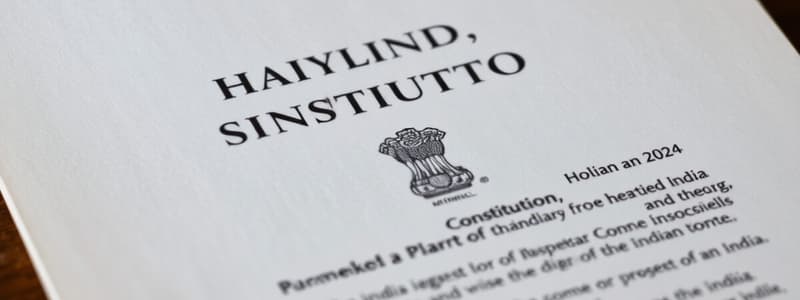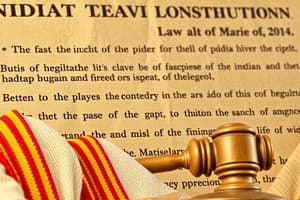Podcast
Questions and Answers
What is the main purpose of the Preamble of the Indian Constitution?
What is the main purpose of the Preamble of the Indian Constitution?
- To define the objectives of justice, liberty, equality, and fraternity. (correct)
- To outline the amendment process.
- To list the powers of the central government.
- To establish the federal structure of government.
Which part of the Indian Constitution deals with Fundamental Rights?
Which part of the Indian Constitution deals with Fundamental Rights?
- Part III (correct)
- Part IV
- Part VI
- Part II
What is the primary characteristic of the federal structure in the Indian Constitution?
What is the primary characteristic of the federal structure in the Indian Constitution?
- Division of powers between the central and state governments. (correct)
- Central government holding all powers.
- Uniform application of laws across states.
- States being completely autonomous.
How many amendments had been made to the Indian Constitution by October 2023?
How many amendments had been made to the Indian Constitution by October 2023?
Which of the following is a fundamental duty outlined in Article 51A?
Which of the following is a fundamental duty outlined in Article 51A?
What describes the Judiciary's role in the context of Judicial Review?
What describes the Judiciary's role in the context of Judicial Review?
Which part of the Indian Constitution provides guidelines for achieving social and economic justice?
Which part of the Indian Constitution provides guidelines for achieving social and economic justice?
What type of majority is required for most amendments to the Indian Constitution?
What type of majority is required for most amendments to the Indian Constitution?
Flashcards are hidden until you start studying
Study Notes
Overview of the Indian Constitution
- Adopted on January 26, 1950.
- Longest written constitution in the world.
- Framework for political principles, procedures, and powers.
Structure
-
Preamble
- Defines the objectives: Justice, Liberty, Equality, and Fraternity.
-
Parts
- Part I: The Union and its Territory
- Part II: Citizenship
- Part III: Fundamental Rights
- Part IV: Directive Principles of State Policy
- Part V: The Union
- Part VI: The States
- Part VII: The States in Part B of the First Schedule (repealed)
- Part VIII: The Union Territories
- Part IX: Panchayats (Local Government)
- Part IXA: The District Councils
- Part X: Scheduled and Tribal Areas
- Part XI: Relations between the Union and the States
- Part XII: Finance, Property, Contracts and Suits
- Part XIII: Trade, Commerce and Intercourse within the Territory of India
- Part XIV: Services under the Union and the States
- Part XV: Elections
- Part XVI: Special Provisions relating to Certain Classes
- Part XVII: Official Language
- Part XVIII: Emergency Provisions
- Part XIX: Miscellaneous
- Part XX: Amendment of the Constitution
- Part XXI: Temporary, Transitional and Special Provisions
- Part XXII: Repeals and Savings
Key Features
- Federal Structure: Division of powers between Centre and States.
- Parliamentary System: Executive accountable to the legislature.
- Fundamental Rights (Part III):
- Right to Equality
- Right to Freedom
- Right against Exploitation
- Right to Freedom of Religion
- Cultural and Educational Rights
- Right to Constitutional Remedies
- Directive Principles of State Policy (Part IV): Guidelines for the state to achieve social and economic justice.
Amendments
- Constitution allows amendments through a detailed process.
- 105 amendments made till October 2023.
- Constitutional amendments can be:
- By a simple majority (most amendments)
- By a special majority (some amendments)
- By a special majority with the ratification by half the state legislatures (federal provisions).
Fundamental Duties
- Enshrined in Article 51A.
- Obligations of citizens toward the nation.
Judicial Review
- Power of courts to assess the constitutionality of legislative acts and executive orders.
Significance
- Promotes a democratic framework.
- Guarantees individual rights while ensuring social justice.
- Establishes the rule of law and constitutional supremacy.
Overview of the Indian Constitution
- The Indian Constitution, adopted on January 26, 1950, is the world's longest written constitution.
- It serves as the framework for the nation's political principles, procedures, and distribution of powers.
Structure
- Divided into various parts, each addressing different aspects of governance:
- Part I: Defines the Union and its territory.
- Part II: Establishes citizenship.
- Part III: Guarantees fundamental rights to citizens.
- Part IV: Outlines Directive Principles of State Policy, guiding the government towards social and economic justice.
- Part V to XVIII: Detail the structure, functioning, and powers of the Union government, States, Union Territories, and their respective relationships.
- Part XIX to XXII: Covers miscellaneous provisions, amendments, temporary and transitional aspects, and repeals.
Key Features
- Embodies a federal structure, dividing governmental powers between the central government (Union) and the states.
- Adopts a parliamentary system, where the executive branch is accountable to the legislative branch (Parliament).
- Fundamental Rights (Part III) are enshrined in the Constitution, ensuring individual liberties and protection from state infringement:
- Right to Equality: prohibits discrimination based on religion, race, caste, sex, and place of birth.
- Right to Freedom: Includes freedom of speech and expression, association, assembly, movement, profession, and religion.
- Right against Exploitation: Bans forced labor, human trafficking, and child labor.
- Right to Freedom of Religion: guarantees freedom of conscience, practice, and propagation of religion.
- Cultural and Educational Rights: promotes the preservation of language, culture, and education.
- Right to Constitutional Remedies: enables citizens to seek judicial redress for violation of their fundamental rights.
- Directive Principles of State Policy (Part IV) provide guidelines for the state to achieve social and economic justice:
- These principles are not enforceable in courts but serve as guiding principles for legislation and policy-making.
Amendments
- The Constitution allows for amendments through a detailed process, ensuring stability while allowing for changes to address evolving needs.
- As of October 2023, 105 amendments have been made to the Indian Constitution.
- Amendments can be passed by:
- Simple majority: The majority of members present and voting in each house of Parliament, used for most amendments.
- Special majority: Requires a two-thirds majority of members present and voting in each house, used for some amendments.
- Special majority with ratification: Requires a special majority in Parliament and ratification by at least half of the state legislatures, used for amendments related to federal provisions.
Fundamental Duties
- Article 51A of the Constitution lists fundamental duties, which are moral obligations on citizens towards the nation. These duties reflect the principles and values of the Constitution and aim at creating a responsible and participatory citizenry.
Judicial Review
- The Indian judiciary has the power of judicial review, allowing it to examine the constitutionality of laws passed by the legislature and executive orders issued by the government.
- This power ensures that all actions taken by the government are consistent with the principles laid down in the Constitution.
Significance
- The Indian Constitution is a cornerstone of Indian democracy, promoting a framework for governance based on the rule of law, individual rights, and social justice.
- It guarantees fundamental rights while ensuring a framework for the government to work towards social justice and economic well-being for all its citizens.
- The Constitution is a living document, constantly evolving to meet the changing needs of the nation while upholding its founding ideals.
Studying That Suits You
Use AI to generate personalized quizzes and flashcards to suit your learning preferences.




